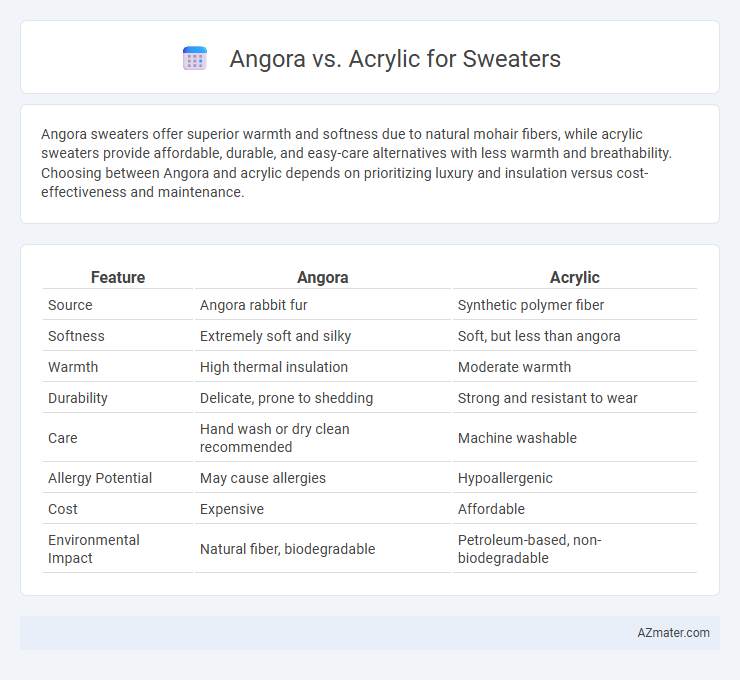Angora sweaters offer superior warmth and softness due to natural mohair fibers, while acrylic sweaters provide affordable, durable, and easy-care alternatives with less warmth and breathability. Choosing between Angora and acrylic depends on prioritizing luxury and insulation versus cost-effectiveness and maintenance.
Table of Comparison
| Feature | Angora | Acrylic |
|---|---|---|
| Source | Angora rabbit fur | Synthetic polymer fiber |
| Softness | Extremely soft and silky | Soft, but less than angora |
| Warmth | High thermal insulation | Moderate warmth |
| Durability | Delicate, prone to shedding | Strong and resistant to wear |
| Care | Hand wash or dry clean recommended | Machine washable |
| Allergy Potential | May cause allergies | Hypoallergenic |
| Cost | Expensive | Affordable |
| Environmental Impact | Natural fiber, biodegradable | Petroleum-based, non-biodegradable |
Introduction: Comparing Angora and Acrylic Sweaters
Angora sweaters offer unparalleled softness and natural insulation derived from Angora rabbit fibers, enhancing warmth and luxury. Acrylic sweaters provide a budget-friendly alternative with durability, easy care, and resistance to moths and shrinking. Choosing between Angora and Acrylic depends on preferences for natural fiber comfort versus low-maintenance synthetic performance.
Fiber Origins: Natural vs Synthetic
Angora fiber originates from the Angora rabbit, making it a natural, renewable resource prized for its exceptional softness and warmth. Acrylic, in contrast, is a synthetic fiber produced from polymer compounds derived from petrochemicals, offering durability and affordability. The natural protein structure of Angora provides superior breathability and insulation compared to the moisture-resistant, less breathable acrylic fibers.
Warmth and Insulation Differences
Angora fibers provide superior warmth and insulation compared to acrylic due to their hollow structure, which traps heat more effectively and offers natural thermal regulation. Acrylic sweaters, while often more affordable and easier to care for, lack the same insulating properties because synthetic fibers do not retain heat as efficiently as natural angora wool. Choosing angora ensures better temperature retention and moisture-wicking benefits, making it ideal for colder climates.
Softness and Comfort Levels
Angora fibers, sourced from Angora rabbits, provide exceptional softness and a luxurious feel, making sweaters incredibly comfortable against the skin. Acrylic, a synthetic fiber, offers good softness but often lacks the natural warmth and breathability found in angora, sometimes causing discomfort for sensitive skin. Sweaters made from angora typically deliver superior comfort due to their lightweight, insulating properties and moisture-wicking abilities.
Durability and Longevity of Each Material
Angora sweaters offer softness but tend to be less durable due to the delicate fibers that can pill and wear out faster with frequent use. Acrylic materials, known for their synthetic resilience, provide greater longevity and resistance to abrasion, maintaining shape and color over time. When prioritizing durability and long-term wear, acrylic sweaters generally outperform angora in retaining their appearance and structural integrity.
Breathability and Moisture Control
Angora fibers excel in breathability and moisture control due to their natural ability to wick moisture away from the skin while maintaining warmth, making sweaters comfortable in varying temperatures. Acrylic, a synthetic fiber, lacks the same moisture-wicking properties and can retain sweat, often causing discomfort during extended wear. For optimal breathability and moisture management, Angora sweaters outperform acrylic counterparts, providing superior regulation of body temperature and dryness.
Care and Maintenance Requirements
Angora sweaters require delicate care, including hand washing with mild detergent and air drying to maintain softness and prevent fiber damage. Acrylic sweaters are more durable and machine washable, making them easier to maintain with less risk of shrinking or pilling. Proper storage for Angora involves avoiding humidity and direct sunlight, while Acrylic can be stored more flexibly without special conditions.
Allergies and Skin Sensitivity
Angora wool, derived from Angora rabbits, is a natural fiber known for its softness but can cause allergic reactions and skin irritation in sensitive individuals due to its lanolin content. Acrylic fibers, synthetic and hypoallergenic, provide an alternative for those prone to allergies or sensitive skin as they lack natural allergens and irritants. Choosing acrylic sweaters reduces the risk of itching, redness, and rashes common with animal fibers, making them suitable for sensitive skin types.
Environmental Impact and Sustainability
Angora wool, sourced from Angora rabbits, offers a biodegradable and renewable fiber option with minimal chemical processing, promoting environmental sustainability. In contrast, acrylic is a synthetic fiber derived from petroleum, contributing to non-biodegradable waste and higher carbon emissions due to its fossil fuel origins. Choosing Angora over acrylic reduces plastic pollution and supports eco-friendly textile practices.
Price Comparison: Angora vs Acrylic Sweaters
Angora sweaters typically cost significantly more than acrylic sweaters due to the premium quality of angora wool, which is harvested from angora rabbits and involves labor-intensive processing. Acrylic sweaters, made from synthetic fibers, offer a budget-friendly alternative with prices often ranging from one-third to one-tenth of angora sweater costs. The price difference directly reflects the natural softness, warmth, and luxury of angora compared to the mass-produced, cost-effective nature of acrylic materials.

Infographic: Angora vs Acrylic for Sweater
 azmater.com
azmater.com